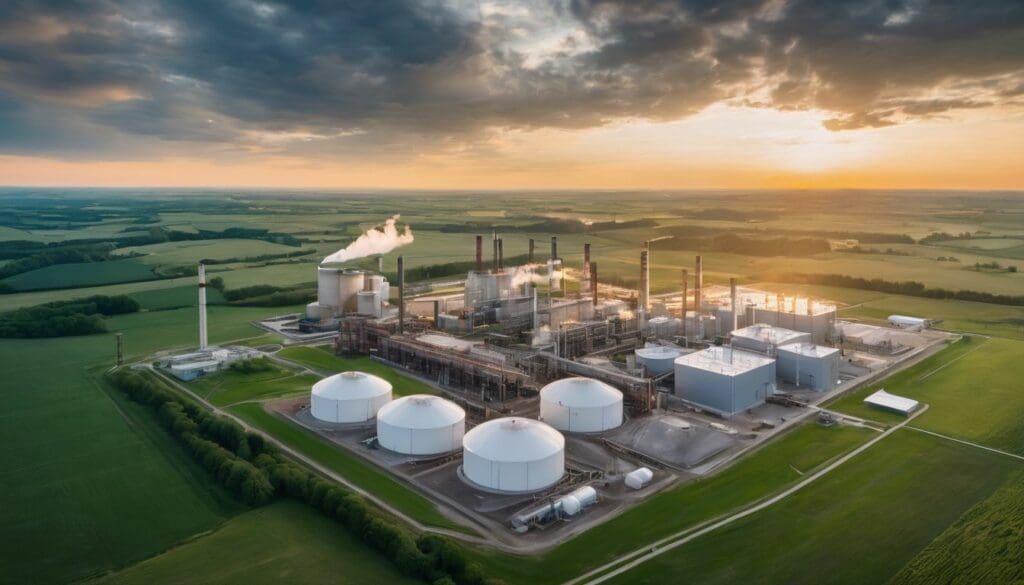Our planet is warming up, and carbon emissions from burning fossil fuels are a big reason why. Every year, industries release billions of tonnes of CO2 into the air. This blog will explain how new tech called Carbon Capture and Storage (CCUS) can help us fight this problem.
Discover how innovations might just be our ticket to a cleaner future!
Key Takeaways
- Carbon Capture, Utilisation, and Storage (CCUS) helps reduce harmful CO2 emissions by capturing carbon from industrial processes and storing it underground or converting it into useful products like e-fuels.
- Global initiatives such as the Paris Agreement support CCUS developments to limit global warming. Novel technologies in CO2 recovery are being created for more efficient and cost-effective solutions.
- CCUS has diverse applications across industries including agriculture, where it can improve sustainability, and e-fuels production which offers alternative clean energy sources.
- Overcoming challenges such as high initial costs is key to implementing CCUS widely; technological advancements are making these methods more feasible and economically viable over time.
- Effective policy coordination, promoting investment in the sector, streamlining project timelines, and fostering industry collaboration are recommended strategies for advancing CCUS implementation globally.
Understanding Carbon Capture, Utilisation, and Storage (CCUS)
Carbon Capture, Utilisation, and Storage (CCUS) involves capturing carbon dioxide emissions from industrial processes or directly from the air, then storing it underground or utilising it in various applications.
It plays a crucial role in clean energy transitions by reducing carbon emissions and helping to mitigate climate change effects.
Definition
Carbon Capture, Utilisation, and Storage (CCUS) stands as a cutting-edge approach aimed at trapping carbon dioxide (CO2) before it enters the atmosphere. This process involves capturing CO2 emissions produced from industrial activities or burning fossil fuels.
Once captured, the gas can either be used to create valuable products like e-fuels or permanently stored deep underground in geological formations.
Involving multiple technologies such as modular carbon capture systems and cryogenic carbon capture, CCUS plays a pivotal role in battling climate change. It enables the efficient use of CO2, turning potential greenhouse gases into useful commodities.
Secure storage methods ensure that this harmful gas doesn’t contribute to global warming, reflecting a major leap towards sustainable development and environmental protection.
Role in Clean Energy Transitions
Carbon capture, utilisation, and storage (CCUS) play a crucial role in the transition towards cleaner energy sources. By capturing carbon emissions from industrial processes and power plants, CCUS helps to reduce greenhouse gas emissions that contribute to climate change.
The captured CO2 can then be used or stored underground, preventing it from entering the atmosphere. This technology enables traditional industries to decarbonise while providing a bridge to a low-carbon future by allowing for the continued use of fossil fuels in combination with renewable energy sources.
In addition to mitigating emissions from existing industrial operations, CCUS holds potential as an enabler for negative emissions technologies such as bioenergy with carbon capture and storage (BECCS).
Current Status and Future Plans for CCUS
Global initiatives and targets for carbon capture, utilisation, and storage (CCUS) are driving developments in technology and innovation. The future plans include scaling up projects and enhancing the efficiency of CCUS technologies to meet emission reduction goals.
Global initiatives and targets
Developments in technology and innovation
- Novel CO2 recovery devices are being developed to enhance efficiency and minimise energy consumption.
- Innovations in CO2 capture technology are emerging, focusing on cost-effectiveness and scalability.
- Research is underway into CO2 utilisation technologies that can convert captured carbon dioxide into valuable products, such as e-fuels.
- Fossil fuel and biomass carbon capture innovations are being explored to expand the scope of industries that can benefit from CCUS technology.
Applications of CCUS
CCUS technologies can be applied in a wide range of industries, including agriculture and e-fuels production, to capture and store carbon emissions from various sources. These applications play a crucial role in reducing greenhouse gas emissions and mitigating climate change.
Agriculture
Agriculture plays a critical role in the fight against climate change, and carbon capture, utilisation, and storage (CCUS) technologies can significantly contribute to reducing carbon emissions from agricultural processes.
By implementing CCUS in agriculture, such as capturing and storing carbon dioxide emissions from livestock operations or using bioenergy with carbon capture and storage (BECCS) to capture CO2 released during biomass combustion, the industry can become more sustainable.
Additionally, utilising captured CO2 for enhanced photosynthesis in greenhouses can lead to increased crop yields while also sequestering carbon. These innovative approaches not only reduce greenhouse gas emissions but also enhance agricultural productivity.
These developments not only address environmental concerns but also have the potential to create additional revenue streams for farmers through the production of renewable energy sources or by participating in carbon offset programmes.
E-fuels production
As we transition from discussing agricultural applications of CCUS to exploring its role in e-fuels production, it’s important to recognise the potential for carbon capture and utilisation in generating sustainable energy sources.
E-fuels, such as hydrogen and synthetic fuels, can be produced using captured CO2 and renewable energy. This innovative process not only reduces carbon emissions but also enables the creation of clean, alternative fuels that can power various industries and transportation sectors.
By leveraging advancements in CO2 conversion technologies and CCS technology, e-fuels production represents a promising avenue for reducing reliance on traditional fossil fuels while contributing to global efforts towards decarbonisation.
Advantages and Challenges of CCUS
Advantages include reduced carbon emissions and the potential for cost-effective methods of capturing and storing CO2. However, challenges such as high initial investment costs and technological limitations need to be addressed for widespread implementation of CCUS.
Reduced carbon emissions
Carbon capture, utilisation, and storage (CCUS) technology plays a crucial role in reducing carbon emissions. By capturing CO2 from industrial processes or power plants and storing it underground, this innovative solution helps to prevent the release of harmful greenhouse gases into the atmosphere.
Additionally, CCUS can also be used to convert CO2 into useful products such as fuels or chemicals, further contributing to reduced carbon emissions and environmental sustainability.
Furthering our efforts in developing and implementing CCUS technologies is essential for effectively mitigating climate change by significantly decreasing the amount of carbon dioxide released into the atmosphere.
Cost and feasibility
Implementing carbon capture, utilisation, and storage (CCUS) technologies presents the challenge of cost and feasibility. The initial investment required for setting up CCUS infrastructure can be considerable, however, ongoing technological advancements are driving down costs and making CCUS more economically viable.
With continued innovation and increased adoption, the cost-effectiveness of CCUS is steadily improving. Feasibility studies also consider factors such as regional geology for underground storage sites, ensuring that carbon dioxide can be securely stored without adverse environmental impacts.
As progress continues in reducing the cost and increasing the feasibility of implementing CCUS technology solutions, it becomes increasingly attainable to integrate them into a broad range of industries.
Recommendations for Implementing CCUS
For successful implementation of CCUS, policy coordination and promotion are essential to incentivise industries in adopting carbon capture technology. Accelerating project timelines is crucial for meeting global targets and investment stimulation can drive innovation in this field.
Policy coordination and promotion
To effectively implement carbon capture, utilisation, and storage (CCUS) technologies, policy coordination and promotion are crucial. Policymakers need to align regulations and incentives to support the development and deployment of CCUS projects.
Promotion efforts should focus on raising awareness about the environmental benefits of CCUS and its role in mitigating carbon emissions. These actions can create a conducive environment for investment in CCUS infrastructure and foster collaboration among industries for successful implementation.
Accelerating project timelines is another key aspect that requires attention when it comes to promoting CCUS initiatives. By streamlining regulatory processes and providing financial support through incentives, government bodies can help expedite the deployment of CCUS projects across various sectors.
Such coordinated efforts will contribute significantly to achieving global targets for reducing carbon emissions while driving innovation in CO2 capture technology.
Accelerating project timelines
To expedite project timelines for Carbon Capture, Utilisation, and Storage (CCUS), industries can streamline research and development processes. They should allocate resources efficiently to advance CO capture technology and CO conversion technologies.
Implementing agile project management methodologies can also help in reducing bureaucratic delays.
Industries may collaborate with governments to establish streamlined regulatory frameworks that support CCUS initiatives. This could involve simplifying permitting processes and providing incentives for the deployment of carbon capture and storage projects.
Investment stimulation
To stimulate investment in carbon capture and storage (CCUS) initiatives, governments and industry leaders need to offer financial incentives and support. This could include tax credits, grants, or subsidies for projects aimed at reducing CO2 emissions through CCUS technologies.
Additionally, clear and consistent policies that create a stable regulatory environment can help attract private sector funding. By providing a more predictable landscape for potential investors, governments can encourage greater participation in CCUS ventures, accelerating the transition towards cleaner energy solutions.
Encouraging collaboration between industries is also crucial in driving investment towards CCUS. Partnerships between technology developers and end-users can foster innovation while sharing the financial burden of implementing these technologies across sectors like agriculture and e-fuels production.
Collaboration among industries
Industries need to collaborate to enhance the development and deployment of carbon capture, utilisation, and storage (CCUS) technologies. Collaboration between sectors such as energy, agriculture, and manufacturing can foster knowledge sharing, promote technological advancements, and drive down costs for CCUS projects.
This collaboration will also create opportunities for innovation in CO utilisation applications across various industries. By working together, industries can accelerate the adoption of CCUS solutions on a larger scale.
To stimulate cross-sector collaboration effectively in advancing CCUS initiatives requires transparent information-sharing platforms. These platforms would enable businesses to exchange best practices and leverage each other’s expertise to overcome common challenges related to implementing CCUS technologies throughout different industrial processes.
Conclusion
Innovations in Carbon Capture and Storage are crucial for tackling CO emissions. Advanced CO recovery devices play a key role in this process. Utilising carbon dioxide and capturing it from fossil fuels are significant steps forward.
These innovative solutions promise a more sustainable future for the environment.
FAQs
1. What are innovations in carbon capture and storage?
Innovations in carbon capture and storage involve new technologies that grab CO2 emissions from the air or fossil fuel use and store it safely away.
2. How do carbon dioxide utilisation methods work?
Carbon dioxide utilisation transforms captured CO2 into useful products, helping reduce harmful emissions while creating valuable materials.
3. Can recovery devices reduce the impact of fossil fuels?
Yes, innovative CO recovery devices are designed to collect a large percentage of CO emissions from fossil fuel sources before they enter our atmosphere.
4. Is storing captured carbon safe for the environment?
The latest advancements ensure that stored carbon is kept secure, preventing it from contributing to climate change and protecting our environment.





